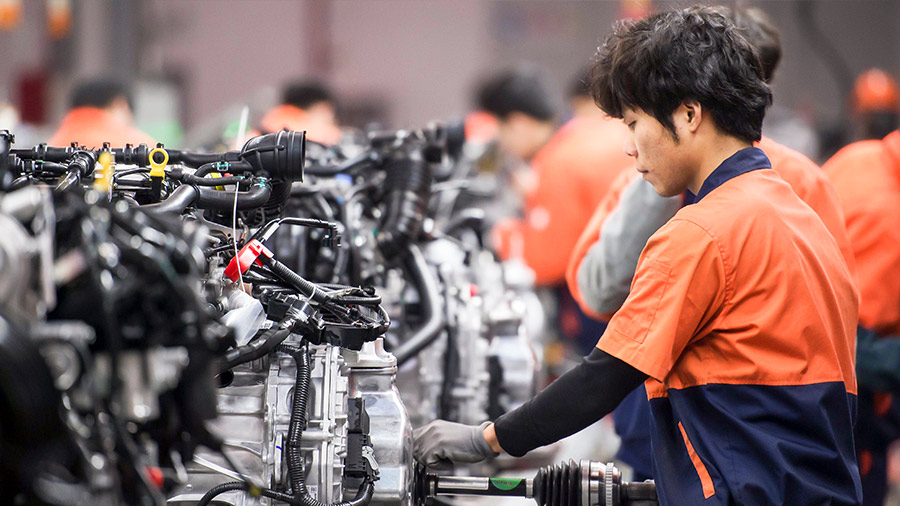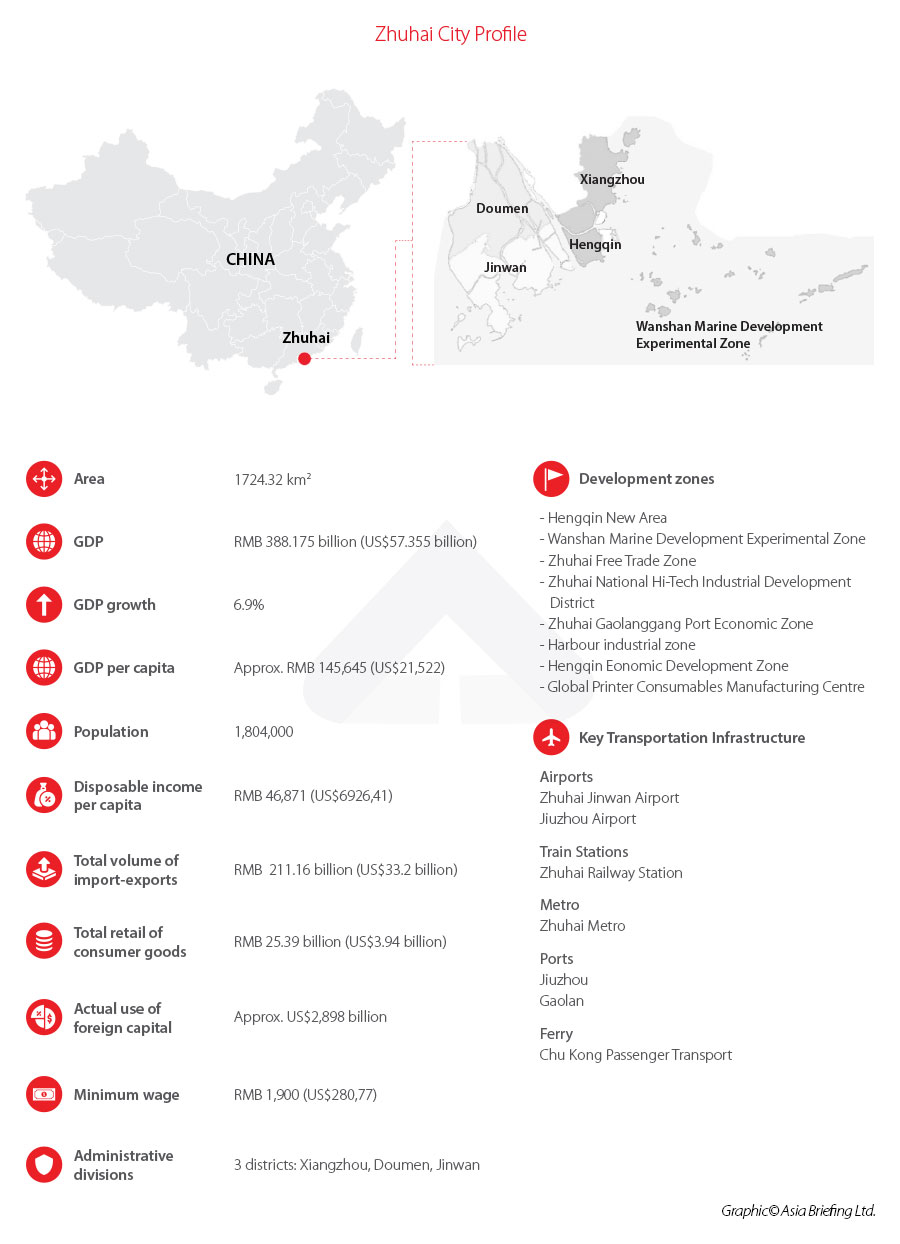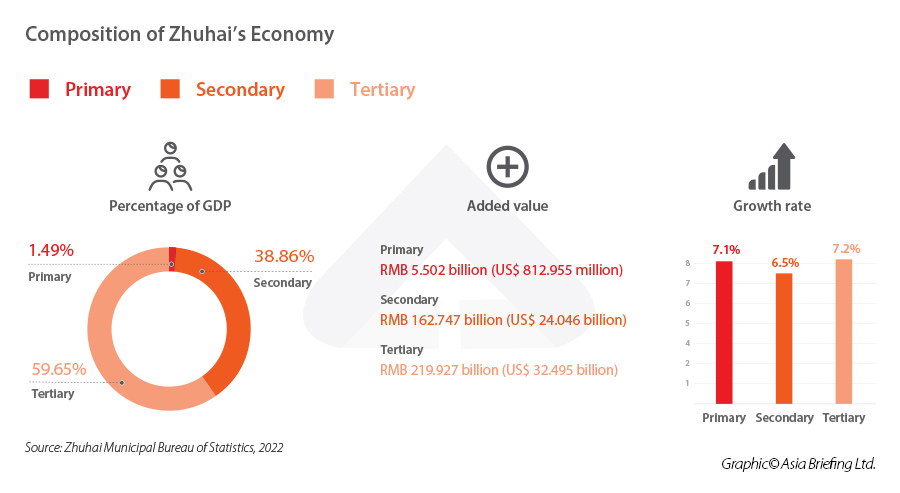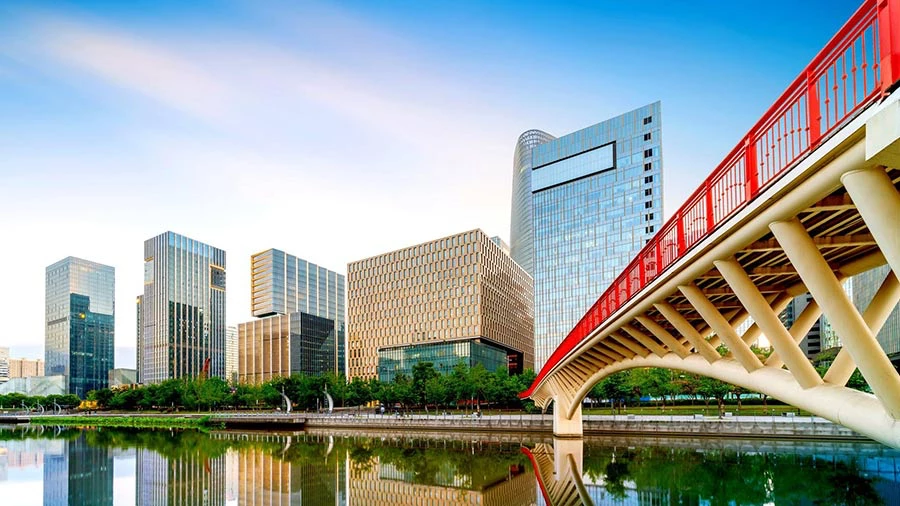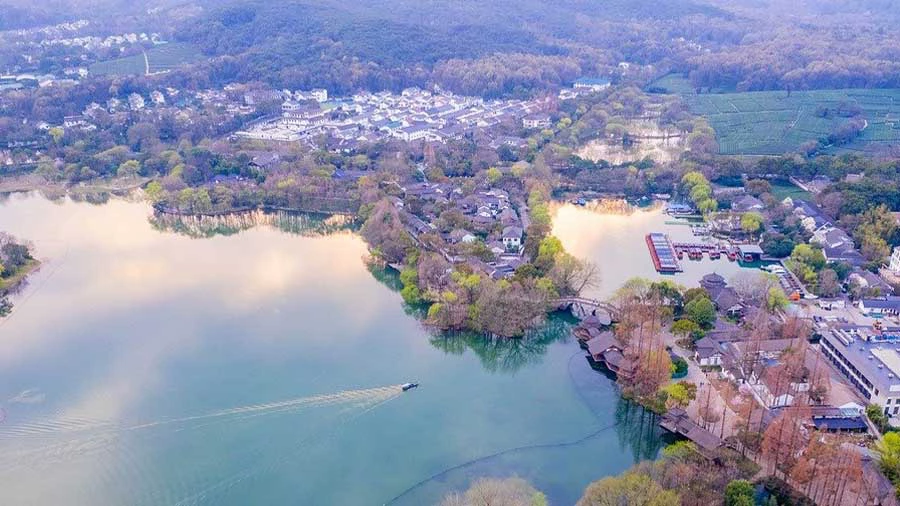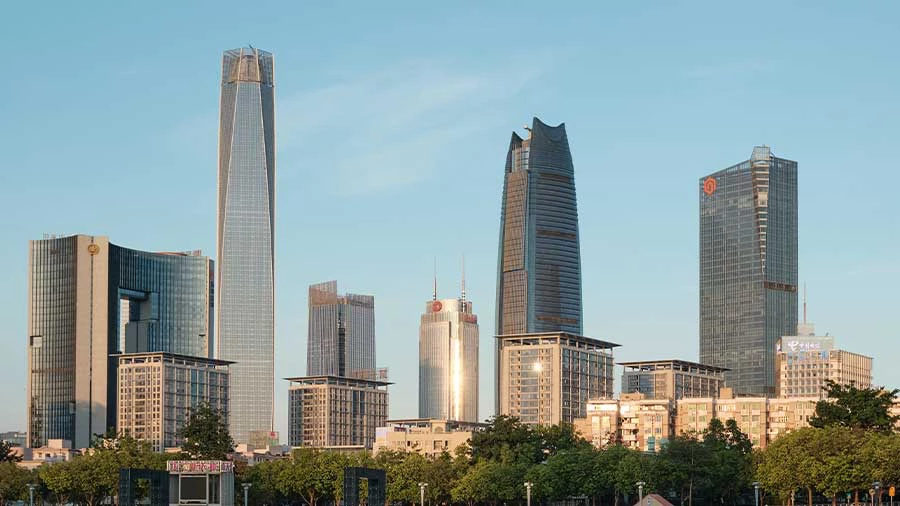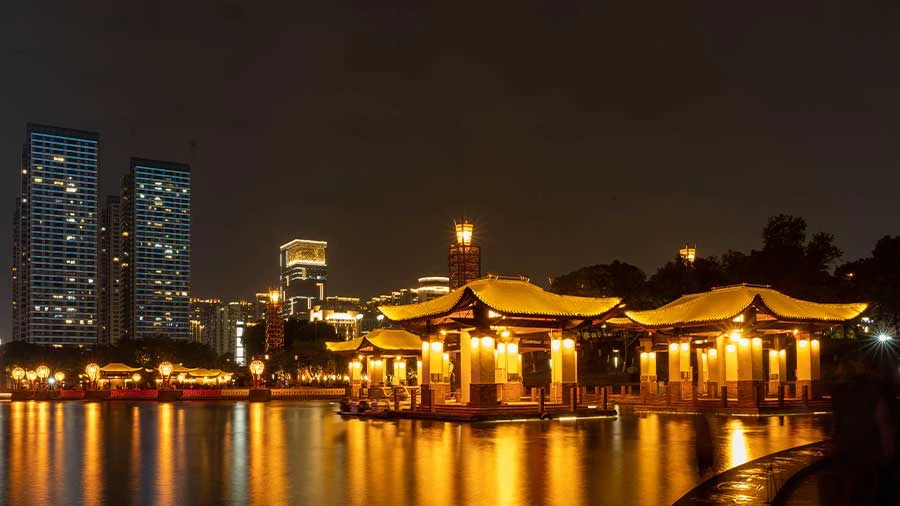Zhuhai (in Chinese 珠海 Zhūhǎi), a prefecture-level city located on the west bank of the Pearl River estuary (China’s third longest river) in the southern Guangdong province of the country, is one of China's first-batch special economic zones approved by the State Council and an important node city in the Guangdong-Hong Kong-Macao Greater Bay Area (GBA).
Its Chinese name translates into "pearl sea", referencing the city's position at the converging point between the Pearl River and the South China Sea. The city is also sometimes known as the Chinese Riviera; with its 690 km of coastline and relatively low population density – Zhuhai is primarily a tourist destination and is considered one of China’s “most livable places” (according to the Chinese Academy of Social Sciences).
The city shares maritime boundaries with Shenzhen and Hong Kong to the northeast across the estuary and borders Jiangmen to the west, Zhongshan to the north, and Macao to the southeast. Zhuhai is also the only city on the Chinese Mainland to have a direct road connection between Hong Kong and Macao through the Hong Kong-Zhuhai-Macao Bridge – the longest cross-sea bridge in the world.
Since the Hengqin Area of Zhuhai began operating in 2015 under the Guangdong Pilot Free Trade Zone (FTZ), the city has taken on a major role in China's Belt & Road Initiative. As of 2022, four state-level special investment zones, namely Zhuhai Bonded Area (which is part of the Guangdong Free Trade Zone), Zhuhai High-tech Industrial Development Zone, Zhuhai-Macao Cross-border Industrial Zone, and Zhuhai Economic and Technology Development Zone, have been launched.
Economic overview
Zhuhai was officially established as a city in 1979, a year before being designated to be among China's initial special economic zones (SEZ). The recognition of Zhuhai as an SEZ was partly due to its advantageous location in proximity to Macao, the capitalist trading hub – a situation comparable to that between Hong Kong and Shenzhen, the latter becoming China’s first SEZ in 1978.The designation of Zhuhai as an SEZ made it easier for the Chinese Central Government to access Macao and, as a result, the worldwide market. Following decades of development, Zhuhai has quickly become a significant city in the Pearl River Delta area. The establishment of the SEZ successfully transformed Zhuhai into a significant port, a center for research and education, a tourist destination, and a transportation hub for the surrounding area.
In 2021, the city's GDP reached RMB 388.175 billion (US$57.48 billion), scoring a year-on-year increase of 6.9 percent. In terms of GDP contribution, Zhuhai’s secondary and tertiary sectors made up the largest share, with a contribution rate of 38.86 percent and 59.65 percent, respectively, while the primary sector accounted for only 1.49 percent. In particular, the added value of the service sector reached RMB 155.146 billion (US$22.97 billion), accounting for 40 percent of the regional GDP.
Foreign trade and investment
Despite the effects of the global COVID-19 pandemic, Zhuhai's total volume of imports and exports got off to a great start in the 14th Five-Year Plan (2021–2025) era, showing strong resilience throughout 2021.The overall number of imports and exports in the city increased by 21.5 percent over the previous year to reach RMB 332.01 billion (US$52.19 billion) in 2021, with exports making up RMB 188.61 billion (US$29.65 billion). Indeed, foreign trade volume increased steadily between the city and its main trading partners. Trade between Zhuhai and ASEAN, the European Union, and the United States increased by 25.6 percent, 30.5 percent, and 4.9 percent, respectively.
Zhuhai exported mechanical and electrical products worth RMB 145.74 billion (US$22.91 million) in 2021, an increase of 13 percent over the previous year. Similarly, the export of integrated circuit (IC) products increased by 141.8 percent to RMB 6.15 billion (US$966.83 million), while the export of home appliances surged by 11.4 percent to RMB 19 billion (US$2.99 billion).
On the other hand, the amount of mechanical and electrical products imported climbed by 29.2 percent to RMB 83.26 billion (US$13.09 billion), while the volume of IC goods increased by 40.5 percent from 2020.
There are three important reasons behind Zhuhai’s success in drawing international investment, and these include its exceptional geographic position, a wide variety of supporting infrastructure, and a deep-water port. In 2021, utilized foreign investment totaled US$2.898 billion, an increase of 13.4 percent from the previous year. Moreover, some of the top 500 companies in the world have set up investment projects in Zhuhai, including ExxonMobil, BP, Siemens, Carrefour, and Matsushita.
Macao remains the city's largest trading partner, accounting for 58.2 percent of the total investment, immediately followed by Hong Kong, which accounted for 43.8 percent of actual foreign capital.
Zhuhai-Macao economic ties
The former Portuguese colony of Macao shares a northern border with Zhuhai's Gongbei and a western border with Zhuhai's Wanzai and Hengqin New Area. Because of such proximity, Macao and Zhuhai have remained extremely interconnected through economic collaboration, cultural exchanges, and social and livelihood integration over the past 20 years.Notably, the Hengqin New Area, founded in 2009, has the specific objective to support the diversification of Macao's industrial growth and deepen Guangdong-Hong Kong-Macao in-depth collaboration.
Hengqin is home to more than 2160 Macao businesses with a combined investment of US$18.83 billion. Since 2019, the Zhuhai-Macao partnership has primarily focused on emerging key industries, cosigning projects in the areas of public-private cooperation, new retailing, big data, and industry incubation among others.
Zhuhai-Hong Kong economic ties
In 2020 Zhuhai’s export to Hong Kong amounted to RMB 27.85 billion, or 17.31 percent of the city's total exports.As of 2018, Hong Kong had launched 3037 projects in the city, with US$5.53 billion in contractual investment and US$1.09 billion in realized direct investment. By the end of 2019, there were 9634 authorized Hong Kong-invested firms in Zhuhai, making up 47.6 percent of all businesses in the city. Hong Kong's contractual direct investment totaled US$37.9 billion, or 49.4 percent of the city's total, while the city's realized direct investment totaled US$14.08 billion, or 42.7 percent of the city's total.
In 2021, the Central Government finalized the Guangdong-Macao Intensive Cooperation Zone Development Plan, and since the opening of the Hong Kong-Zhuhai-Macao Bridge, Zhuhai has grown even closer to both Hong Kong and Macao, creating favorable circumstances for Hong Kong's involvement in development projects, such as in Hengqin New Area.
Industry development
Zhuhai’s production focuses on industries like home appliances, integrated circuits, biomedicine, new energy, new materials, and high-end printing equipment, and it will continue to do so under China’s 14th Five-Year Plan, which intends to grow the city into a global advanced manufacturing base and a hub for industrial innovation. Zhuhai also wants to hasten the growth of new businesses, including information technology, high-end medical technology, and intelligent manufacturing.Zhuhai is set to develop a variety of service-related businesses, including information services, science, and technology services, supply chain services, professional services, industrial design, and cultural and creative services. Additionally, the city is accelerating the development of national logistics hubs and will enhance the function of hubs at airports, ports, and bonded logistics parks. Additionally, Zhuhai is expected to increase the number of 5G applications in the service sector by fostering the growth of specialized segments like smart tourism, smart education, and smart healthcare.
Zhuhai's key development areas
Thanks to its strategic position, the city of Zhuhai hosts several national-level development zones, including the Zhuhai Economic and Technological Development Zone, the Zhuhai High-Tech Industrial Development Zone, and the Zhuhai Bonded Zone. It is also home to three provincial-level industrial parks, namely, the Doumen Fushan Industrial Park, the Jinwan Liangang Industrial Park, and the Doumen Intelligent Manufacturing Industrial Park. The Sanzao Science and Technology Industrial Park, the Xinqing Science and Technology Industrial Park, and the Nanping Science and Technology Industrial Park fall under the direct management of the Zhuhai High-tech Zone.Moreover, several other key projects have contributed to the growth of the city, giving rise to highly specialized industrial clusters.
Hengqin New Area
In 2021, the State Council officially announced the establishment of the Guangdong-Macao Intensive Cooperation Zone on Zhuhai's Hengqin island. Indeed, Hengqin is the largest island in Zhuhai's southernmost region, and it is located barely 200 meters away from Macao's closest point, while it connects to it by a bridge. Therefore, the natural advantage of Hengqin presents a fantastic potential to boost the growth of the Guangdong-Hong Kong-Macao Greater Bay Area and to improve collaboration between the Guangdong province and Macao.The plan, which includes a special financial taxation system and a customs control system, was unveiled to encourage Macao's economic diversification, which mostly depends on the gaming and entertainment industries, as well as the growth of the Greater Bay Area. The project's launch introduced 12 investment projects and the groundbreaking for the new customs building. To further the development of the GBA, the Zhuhai Human Resources & Social Security Bureau conducted a series of initiatives in the fields of employment, social security, talents, and public services. These also translated into various Hong Kong-specific preferential policies.
Hengqin offers a variety of favorable policies for Hong Kong residents and businesses, including a refund on income tax payments over 15 percent for residents of Hong Kong and the application of enterprise income tax at a reduced rate of 15 percent for qualified Hong Kong businesses. As a result, there are over 1324 Hong Kong-invested firms registered in Hengqin, the majority of which belong to the tourism and culture sectors. In May 2022, the Ministry of Finance (MOF) and State Tax Administration (STA) announced a new round of preferential tax policies for companies based in the area.
Hengqin is also part of the Guangdong FTZ, and as such, it has implemented several innovative policies over the years. For instance, the area was among the leaders in establishing a nationwide reform of business registration and introducing the first batch of multi-currency UnionPay IC cards, while also launching a pilot franchise company for individual domestic-foreign currency exchange.
Zhuhai Bonded Area
The Zhuhai Bonded Area is located near the Shizimen Central Business District, Hengqin New Area, and Wanzai, and it faces Macao to the east. It was established under the State Council mandate in 1996 and started operating in 1999 as the only FTZ on the west bank of the Pearl River estuary.The 3-sqkm (1-sq mile) bonded area actively participates in Macao's economic and commercial exchange. It fully utilizes the benefits of bonded warehousing, tax-refunded exports, and 24-hour customs clearance to enhance logistics, trade shows, sales, and international e-commerce. In addition, the area is also growing sophisticated manufacturing and related production-oriented service sectors.
Companies such as MTU Maintenance, Zhuhai Xiangyi Aviation Technology, XH Smart Tech (China), as well as other domestic businesses, have shown significant growth momentum supported by favorable taxes, foreign exchange management, and customs control regulations.
As a result, the Zhuhai Bonded Area has drawn US$240 million in international investment. As of 2021, the area was home to more than 1,200 businesses, providing employment to over 20,000 people. During the 13th Five-Year Plan era (2016-2020), the annual GDP growth was 8.9 percent, with the added value of industrial businesses standing at 6.8 percent, and fixed-asset investment at 78 percent.
Together with the Hengqin and Hongwan neighborhoods, the zone is creating a new city center. Thanks to its proximity to the Hong Kong-Zhuhai-Macao Bridge, it also plays a significant role in the GBA broader economic zone.
Zhuhai-Macao Cross-Border Industrial Zone
The Zhuhai-Macao Cross-Border Industrial Zone was established in 2003 and opened for business in 2006. The area was set up to strengthen economic ties between Guangdong Province and the former Portuguese colony and is considered among the driving factors behind Macao's long-term stability and growth.The industrial zone covers a total area of 40 hectares (99 acres) and it falls into the Zhuhai FTZ in Wanzai. The area is also located less than 1 km away from the Hong Kong-Zhuhai-Macao Bridge's passenger transport exit and is in close proximity to the intercity MRT Zhuhai Station as well as the Zhuhai (Jinwan) Airport. It is also close to some of Zhuhai's most popular retail areas, including Hengqin, Shizimen Central Commercial District, and Gongbei's core business area, making it a suitable entry point for imported products onto the Chinese Mainland.
Taking advantage of the FTZ regulations, preferential taxation of export-import commodities and checkpoints with 24-hour customs clearance, Zhuhai Park fosters businesses in the cross-border e-commerce, warehousing, and logistics sectors.
Gaolan Port Economic Zone
The National Zhuhai Economic & Technological Development Area (or Gaolan Port Economic Zone) has established a comprehensive harbor industry encompassing 380 square kilometers (147 square miles), and is located in Jinwan District, in the southwest part of the city.First established as Gaolan Port Economic Zone in 2006 as a South China hub port, the area was upgraded into a national-level development zone in 2012. The economic zone houses the largest terminals for liquid chemicals and bulk cargos in the Pearl River Delta. Acting as one of the main chemical industry clusters of Guangdong, it is also becoming a world-class base for shipbuilding and ocean engineering equipment manufacturing, and a state-level clean energy and petrochemical hub, as well as a regional logistics center.
Since 2012, the port has improved its distribution network, partly due to the opening of the Guangzhou-Zhuhai Railway and Gaolan Port Expressway. Additionally, a multimodal freight yard on the Exclusive Shugang Rail Line was set to be built in June 2021, linking Gaolan Port directly with significant ports and businesses that deal with larger cargoes.
Fine chemicals, petrochemicals, electricity, energy, offshore equipment manufacture, and leisure tourism have all come together to establish a harbor industry cluster. Here are some of the Fortune Global 500 companies that have established their presence in the area presence: BP, SANY, Shell, Lubrizol, Solvay, Hutchison Whampoa, PetroChina, SinoChem, COSCO, and Shenhua.
The port maintains 44 shipping routes to more than 10 countries and regions, serving as a gateway between the Xijiang River and the South China Sea, and the rest of the world.
Zhuhai Wanshan Marine Development Experimental Zone
The Zhuhai Wanshan Marine Development Experimental Zone (or Wanshan Zone), one of the first comprehensive locations of its kind in China, was founded in October 1998. The area today significantly contributes to the city’s “Blue Marine” growth, as well as to its social and economic development.The Wanshan Zone, which spans 4,567 sq km (1,763 sq miles) of sea and 105 islands of varying sizes, is located southeast of Zhuhai in the Pearl River estuary between Hong Kong and Macao. The area hosts one of the most famous fisheries in China and various protected species like corals, white dolphins, and macaque monkeys.
In addition, the Wanshan Zone hosts several harbors suitable for deep-water ports in a 1,000 square kilometer (386 square miles) area dedicated to international yachting and fishing.
With high-speed ferry lines connecting all the main islands, the Wanshan Zone is facilitating both industrial innovation and ecological protection, while also generating coastal tourism and transforming into a top-notch ocean destination in the Hong Kong-Zhuhai-Macao Greater Bay Area.
Pingsha yacht and leisure zone
Located in Zhuhai’s Jinwan District, the coastal town of Pingsha began establishing its yacht building industry as early as 2002.What was originally a modest domestic sector has expanded over the past two decades to become China's oldest, largest, and highest-grade yacht manufacturing base. So much so that in 2008 Pingsha was awarded the title of Guangdong (Yacht) Technological Innovation Professional Town. With the help of the Zhuhai Municipal Government and further market expansion, in 2021, the area became home to 77 yacht-related businesses, classified into 44 service businesses, 10 upstream and downstream firms, and 23 boat manufacturers.
The petrochemical sector, marine engineering equipment, port logistics, and other cutting-edge enterprises created by the Gaolan Port Economic Zone coexist side by side with the boat construction industry in Pingsha.
Key enterprises in the area include Zhuhai Sunbird Yacht Manufacturing, Guangdong Jianglong Shipbuilding, Zhuhai McConaghy Boats, Heysea Yachts, and Zhuhai Sunway Yacht.
Zhuhai National High-Tech Development Zone
The Zhuhai High-Tech Industrial Development Zone was among the first of its kind to be approved by the State Council in 1992. It includes the Main Park in Tangjiawan Town (northern Zhuhai), the Science & Technology parks in Nanping (Xiangzhou), Sanzao (Jinwan), Xinqing (Doumen), and Fushan (Doumen), as well as the Aviation (Jinwan) and Hengqin Hi-Tech & Sci-Tech R&D industrial parks.As of 2021, the park developed three RMB 10 billion (US$1.54 billion) industrial clusters focused on software and integrated circuits, biopharmaceuticals and medical devices, and intelligent manufacturing and robotics. Cutting-edge industries, such as new materials, new energy, and high-end printing equipment, are also in the works.
The zone's regional GDP climbed 6.7 percent from the previous year to RMB 26.81 billion (US$4.14 billion) in 2020, with a yearly increase in the investment in fixed assets at 17.9 percent.
Some of the businesses based in the area include ABB Group, Jafron Biomedical, Meizu Technology, Duowan Technology, Kingsoft Software, Ygsoft Inc, and Zhuhai Rossini Watch Industry, among others.
Key policies assisting foreign investors in Zhuhai
Acting as an open door to the outside world, the Zhuhai government has put in place several policies to attract foreign investors. In 2018, the municipal administration unveiled a number of policies and initiatives aimed at increasing Zhuhai's global exposure and maximizing foreign investment. The measures covered a total of 10 categories, including a variety of incentives sustained by beneficial federal, state, and local policies.Key actions included increasing international investors' access to the market, encouraging foreign investment in regional development, increasing financial rewards for using foreign investment, encouraging innovation and research, and enhancing safety measures, among others.
Incentives are provided for wholly foreign-owned businesses to join Zhuhai's sophisticated industrial system and to design, produce, and maintain special purpose vehicles (SPVs) – subsidiary companies formed to undertake certain purposes or activities. Foreign players are encouraged to work in the fields of building new energy vehicles and designing, building, and maintaining ships and airplanes for both specific and general use.
Additionally, prohibitions on banks and financial asset management firms' foreign shareholdings are lifted. The simultaneous establishment of branches and sub-branches is permitted for foreign banks. Foreign investors are further encouraged to form joint ventures with enterprises that deal with securities, securities investment funds, futures, and life insurance.
Meanwhile, Zhuhai has opened its doors to overseas R&D organizations and innovation teams. A one-time award of up to RMB 1 million (US$145,700) is granted to organizations recognized for the first time as new-type R&D organizations at the local level. A one-time subsidy of up to RMB 1.5 million (US$218,600) is allocated to academician workstations at the city level that is recognized as such for the first time. Additionally, an incentive threshold was established at RMB 100 million (US$15 million) for newly introduced firms as well as for capital growth and expansion, in line with provincial policy.
The measures also include giving preferential treatment of land use to regional headquarters of the World Top 500 firms and worldwide leading enterprises, as well as those of industrial projects with an investment margin of RMB 1 billion ($146 million) and above.
Another important point to mention is that domestic and foreign businesses enjoy the same rights under Zhuhai's Measures on Reducing Cost of Manufacturing Enterprises & Supporting Real Economy Development.
Investing in Zhuhai
Zhuhai offers favorable investment opportunities mostly because of its strategic location. With an estimated 110 million residents and a GDP of RMB 5 trillion (US$726 billion), the Pearl River Delta, where it is located, is the biggest metropolitan area in the world. Additionally, Zhuhai is 150 km or less from Guangzhou, Foshan, Dongguan, and Shenzhen. It shares a border with Macao, which is close to Hong Kong with a bridge connecting them. This makes it possible to take advantage of a broad consumer base and readily access suppliers and clients.Zhuhai has a business-friendly climate because of its SEZ status, made up of three state-level economic projects, the Hengqin Pilot Free Trade Zone, the Zhuhai National Hi-Tech Industrial Development Zone, and the Zhuhai Gaolan Port Economic Zone.
By providing incentives for sophisticated manufacturing, high-tech businesses, and services, as well as import-export operations, the local government has sped up the development of the SEZ. Since hundreds of small and medium-sized businesses have established headquarters in Zhuhai, this has caused the city to create a strong industrial foundation. More than 12,000 projects from 70 different countries have received over US$13 billion in foreign direct investment in the past decade.
Zhuhai has also drawn notice for its stunning natural surroundings and excellent standard of living. Ten institutions, including the University of International Business and Economics, Fudan University, and Huazhong University of Science & Technology, as well as a few technical schools, are in Zhuhai, ensuring there is a supply of talent and skilled workers.



